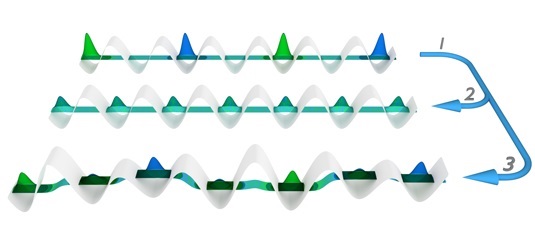07/31/2015
What happens if one mixes cold and hot water? After some initial dynamics, one is left with lukewarm water—the system has thermalized to a new thermal equilibrium. This is true not only when we pour cold milk into our hot coffee, but it is also what happens for almost all interacting systems we know in nature: in the long run they all approach a thermal state with an associated temperature. In this thermal state, the system typically behaves very classically, any initial quantum effects would have been diluted over the whole system and typically cannot be detected anymore. A team of researchers from Ludwig-Maximilians University (LMU) and the Max Planck Institute of Quantum Optics (MPQ) lead by Prof. Immanuel Bloch and Dr. Ulrich Schneider in collaboration with the theory group of Prof. Ehud Altman at Weizmann Institute, Rehovot, have now for the first time created and analyzed a so-called Many-Body Localized state, where despite the presence of interactions the many-body state fails to act as its own heat bath and does not thermalize. In this peculiar insulating state the system retains a quantum memory of its initial quantum state, even for long times. Their results will be published this week inScience Express, the advanced online publication venue of Science.
In a metal the particles that carry energy and electric charge can move freely and spread out over the entire sample allowing the mixing that leads to thermal equilibrium. There are however mechanisms that can hinder such transport. For example in a band insulator, every atom in the crystal has completely filled energy levels or shells. Because of the Pauli principle, electrons in a band insulator cannot move to the filled shell of the nearby atom. Disorder, in the form of impurity atoms, can also localize quantum particles through a mechanism discovered in 1958 by Nobel-prize winner P. W. Anderson. But neither mechanism is completely effective in actual solids. In a band insulator, for example, a fraction of the charge carriers is always thermally excited to empty atomic orbitals of higher energy, thereby allowing free motion. In a disordered Anderson insulator, the electrons, which would ideally be localized, are kicked around by thermal vibrations of the crystal that ultimately spread them out over the entire system.
A fundamental open question
But what if the particles were trapped in a rigid lattice that does not vibrate? Would the system then remain localized at elevated temperature and fail to attain thermal equilibrium? This is still a fundamental open question. Anderson’s theory of localization was originally formulated for non-interacting particles. If the particles interact, as they generally do, then one particle is kicked and should be delocalized by the thermal motion of the neighboring particles. Remarkably, Basko, Aleiner & Altshuler predicted in 2005 the exact opposite effect: under special circumstances, a many-body localized state of mattershould remain stable up to a critical temperature in the system. Above the critical temperature or for weak enough disorder, the particles are delocalized and the system thermalizes under its own intrinsic dynamics. Today, it is understood that this exotic transition presents a sharp boundary between a macroscopic system that shows strong quantum behaviour and one in which quantum effects are washed away in the dynamics.
Many body localized systems are of fundamental interest as the only generic exceptions to thermalization; they represent a new class of systems that fail to be described by standard thermodynamics and statistical physics and require new theoretical and experimental approaches to charcaterize them. At the same time many-body localization is of potential interest for applications in quantum information science as a means to protect the quantum information from decoherence. But in spite of the fundamental interest in the subect, until now an experimental observation and investigation of this intriguing phenomenon has been lacking.
Precisely controlled in the experiment
In their manuscript, the Munich and Weizmann researchers present now an experimental observation of many-body localized states for ultracold potassium atoms in an artificial crystal of light, a so called optical lattice that is created by overlapping and interfering several laser beams. The optical lattice represents a microscopic grid of tiny light spots in which the atoms can be trapped, such that a rigid and random potential for the atoms is realized along one direction of motion. Both the strength of the disorder and of the interaction between the atoms can be precisely controlled in the experiment.
The team then directly tested whether the intrinsic dynamics of the interacting atoms in the optical lattice brings them to thermal equilibrium. To this end, they prepare the system in a state with an imprinted density ripple and measure how such an imprint evolves with time. If the dynamics is thermalizing, then the density modulation is rapidly lost as the thermal equilibrium must bear no memory of the initial state. Conversely, a persistent density modulation after the system has relaxed indicates localization. In this way the researchers mapped out the boundaries of the localized phase with changing disorder and interaction strengths.
The team reproduced the known non-interacting case as a benchmark, while the experimental findings were supported with theoretical calculations and simulations performed by the Weizmann team. The presence of interactions complicates the problem immensely, as joint quantum motion between all particles has to be taken into account. While the non-interaction problem can be solved on any home computer, the theorists at Weizmann Institute had to use a supercomputer to simulate the behavior of only 40 interacting particles even for short times.
“We were astonished to see the lifetimes of this novel state” says Michael Schreiber, the leading PhD student, “Even though it is very quantum in nature, it is also much more stable than any typical many-body state we have looked at in the past.”
(Science Express 2015)















